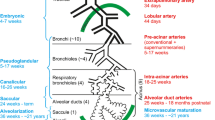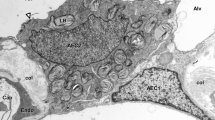Summary
A new heart preparation was developed which permits in situ measurements of myocardial oxygen consumption and substrate uptake in small animals. Using this new method the mechanical activity, as well as oxygen consumption and substrate uptake of the heart, was measured in Goldblatt rats with left ventricular hypertrophy of about 40%.
-
1.
In agreement with former investigations on the hypertrophied rat heart, this model also shows that both the performance of the whole ventricle, as well as the contractile force per unit of cross-sectional area, is increased in the state of stable hypertrophy.
-
2.
The absolute values of oxygen consumption and substrate uptake are increased in the hypertrophied hearts. However, oxygen consumption and substrate uptake as related to muscle mass and to wall stress were largely identical in hypertrophied and control hearts.
-
3.
Hypertrophied hearts and controls utilize substrates according to their respective arterial blood concentration. Under our experimental conditions approximately 50% of the total energy in both groups is obtained from glucose, 30% from lactate, and 20% from fat. The relatively high consumption of lactate could be explained by the glucose uptake and lactate release of the erythrocytes.
Zusammenfassung
Es wurde ein neues Herzpräparat entwickelt, das auch an kleinen Tieren die Messung von Sauerstoff- und Substratverbrauch in situ ermöglicht. Mit dieser neuen Methode wurden sowohl die mechanische Aktivität als auch der Sauerstoff-und Substratverbrauch des Herzens an Goldblattratten mit einer linksventrikulären Hypertrophie von ca. 40% gemessen.
-
1.
In Übereinstimmung mit früheren Untersuchungen am hypertrophierten Herzen wurde auch mit der neuen Methode im Stadium der stabilen Hypertrophie sowohl eine gesteigerte Leistungsfähigkeit des Gesamtventrikels als auch eine Erhöhung der querschnittsbezogenen Kraftentwicklung gefunden.
-
2.
Der absolute Sauerstoff- und Substratverbrauch war bei den hypertrophierten Herzen erhöht. Bezieht man den gemessenen Sauerstoff- und Substratverbrauch jedoch auf die Muskelmasse und die entwickelte Wandspannung, dann ergeben sich für die hypertrophierten Herzen und die Kontrollen weitgehend übereinstimmende Werte.
-
3.
Sowohl hypertrophierte Herzen als auch Kontrollen verbrauchen die einzelnen Substrate entsprechend ihrer jeweiligen Konzentration im arteriellen Blut. Unter unseren experimentellen Bedingungen wurden etwa 50% der gesamten Energie durch die Verbrennung von Glukose, 30% durch Laktat und 20% durch Fett bereitgestellt. Der relativ hohe Laktatverbrauch läßt sich durch die Glukoseaufnahme und Laktatproduktion der Erythrozyten erklären.
Similar content being viewed by others
References
Ballard, F. B., W. H. Danforth, S. Naegle, R. J. Bing: Myocardial metabolism of fatty acids. J. Clin. Invest.39, 717–723 (1960).
Bing, R. J.: Myocardial metabolism. Circulation12, 635–647 (1955).
Bing, R. J.: Cardiac metabolism. Physiol. Rev.45, 171–213 (1965).
Gamble, W. J., P. A. Conn, A. Edelji Kumar, R. Plenge, R. G. Monroe: Myocardial oxygen consumption of blood perfused, isolated, supported rat heart. Amer. J. Physiol.219, 604–612 (1970).
Gibbs, C. L.: Cardiac energetics. Physiol. Rev.58, 174–254 (1978).
Gunning, J. F., H. N. Coleman: Myocardial oxygen consumption during experimental hypertrophy and congestive heart failure. J. Mol. Cell. Cardiol.5, 25–38 (1973).
Hirche, Hj., H. D. Langohr: Hemmung der Milchsäureaufnahme im Herzmuskel narkotisierter Hunde durch hohe arterielle Konzentration der freien Fettsäuren. Pflügers Arch.293, 208–214 (1967).
Keul, J., E. Doll, H. Steim, U. Fleer, H. Reindell: Über den Stoffwechsel des menschlichen Herzens. III. Der oxydative Stoffwechsel des menschlichen Herzens unter verschiedenen Arbeitsbedingungen. Pflügers Arch.282, 43–53 (1965).
Kissling, G., T. Gassenmaier, M. F. Wendt-Gallitelli, R. Jacob: Pressure-volume relations, elastic modulus, and contractile behaviour of the hypertrophied left ventricle of rats with Goldblatt II hypertension. Pflügers Arch.369, 213–221 (1977).
Neely, J. R., K. M. Whitmer, S. Mochizuki: Effects of mechanical activity and hormones on myocardial glucose and fatty acid utilization. Circulat. Res.39, Suppl. I22-I29 (1976).
Sandler, H., H. T. Dodge: Left ventricular tension and stress in man. Circulat. Res.13, 91–104 (1963).
Author information
Authors and Affiliations
Additional information
Paper, presented at the Erwin Riesch Symposium, Tübingen, April 3–7, 1979
With 3 figures and 1 table
Supported by the Deutsche Forschungsgemeinschaft.
Rights and permissions
About this article
Cite this article
Kissling, G. Oxygen consumption and substrate uptake of the hypertrophied rat heart in situ. Basic Res Cardiol 75, 185–192 (1980). https://doi.org/10.1007/BF02001412
Issue Date:
DOI: https://doi.org/10.1007/BF02001412




